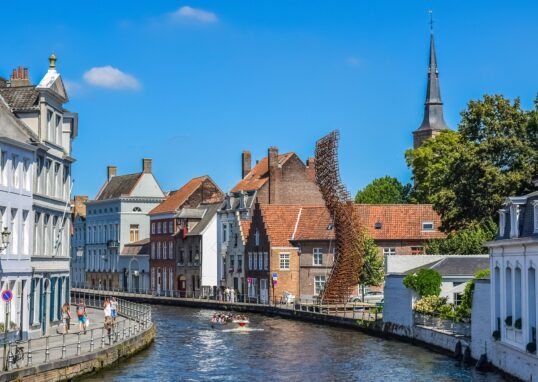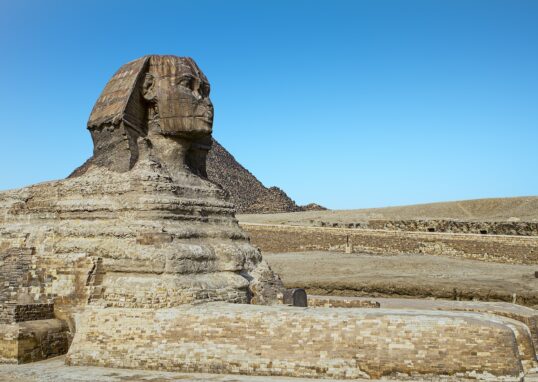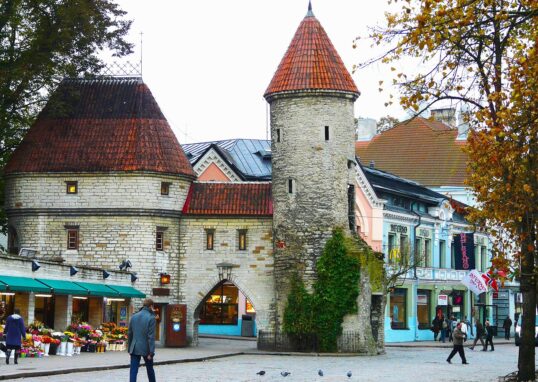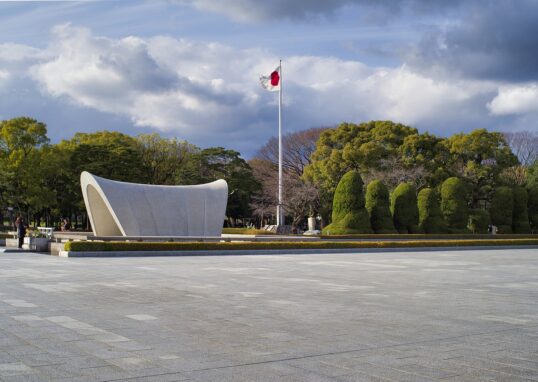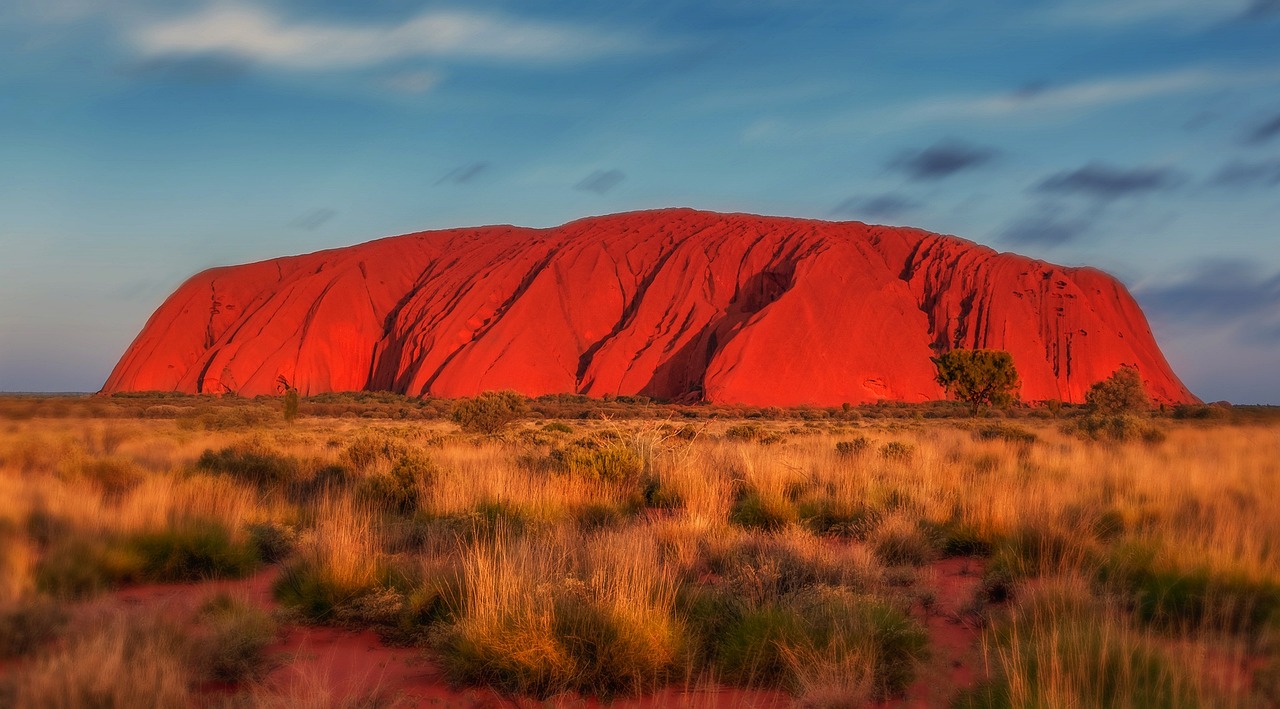
Where Time Curves Like a Boomerang: Uluru’s Eternal Presence
Uluru, commonly known as Ayers Rock, is a renowned Australian tourist attraction protected as a UNESCO World Heritage Site. The enormous sandstone rock stands out from the plain and is situated right at the center of the Red Centre of the Northern Territory, a region composed of arid, sandy land. Uluru is a claypan that can be flooded, and the highest Ant in the mountain forest is a small hill that the ants build before flooding. It is one of the big ones that rose to the skies, the mythical giant ants. Uluru is the ancestral site of the Anangu people. With its unique contours, color, and the presence of the Anangu, it has become an iconic nature park.
Geological Marvel, Uluru, Australia
Uluru is a rock monolith and a natural wonder of Australia, having been formed approximately 500 million years ago. It reaches a maximum height of 348 meters (1,142 feet), with most of its height underground. It is a 9.4-kilometer (5.8-mile) looped megalopolis surrounded by the Uluru-Kata Tjuta National Park. This is also where the Kata Tjuta (commonly known as the Olgas), a set of high-arching, domed rocks, is located.
The vertical edges of this formation are spotted on the sandstone with red areas due to the high iron content in the material. It is interesting to know that sandstone rocks of this type consist mainly of feldspar minerals. Every year, during the pre-dawn hours, one can view the mysterious light phenomenon known as “Electric Blue” over the Cascade Mountains with a pink base projected onto the mountain. This is due to Ice Parhelia, such as light refraction, so if the sky is too cloudy to see them, atmospheric haze can also be cool.
Cultural Significance: Uluru and the Anangu People
Uluru is a sacred site to the Anangu, the local Aboriginal people. Tjukurpa (Dreamtime) is the central theme of the Anangu way of life, serving as the spiritual foundation of their lives, laws, and land management. The Anangu tribe is supported by the power of the local spirits, and all their rules and regulations are defined by these spirits, which is the reason for the existence of this place. They believe that ancestral beings created Uluru, and it is a living place that is occupied by their presence. Several ancient stories have been passed down through the generations, representing the history and legends of different segments of Uluru. Many of these are secret and, therefore, cannot be communicated to non-Indigenous people, demonstrating the profound respect that the Anangu hold for their cultural and spiritual heritage.
The caves around Uluru feature prehistoric rock art created by the Anangu, which records the people’s creation stories, cultural practices, and past lives. Mutitjulu waterhole is the main attraction on the base of Uluru, considered a sacred site for Kuniya and home to a venomous snake (Liru) and a python. The Anangu tribe inhabited the land for 60,000 years and, to this day, still follows their language, laws, and traditions.
Uluru-Kata Tjuta National Park
Uluru and Kata Tjuta National Park are synonymous terms that provide access to 512 square miles of the park’s 1,326 square kilometers. The park shares land and responsibilities between the Anangu people and Parks Australia, presenting a rare example of cooperative conservation and cultural preservation. Kata Tjuta, a nearby dense group of rocks with 36 domes, is a regional spiritual center to the Anangu and a remarkable addition to Uluru.
The national park offers tours that enable travelers to explore Australia’s diverse desert regions. Contrary to what you may think, these ecosystems are characterized by various plant and animal groups. The park teems with life, including six kinds of Marsupials, four types of bats, twenty-one species of mammals, seventy-three species of reptiles, one hundred seventy-eight bird species, and endangered plant species. Many of these plant and animal species are found only in the desert. It offers various activities, including guided walking tours on which the guides lecture on nature, culture, and the park’s formation.
Some of the most popular activities include:
Base Walk
One of the most important tourist attractions in the town is the Uluru Base Walk, which winds around the rock for 10.6 km. Travelers can bank on being close to the awe of the rich offspring. This trek will take approximately 3.5 to 4 hours and pass through various landscapes, including woodlands, watering holes, and desert plains. On the way, visitors can uncover the mysteries of the caves and the cave art, and enjoy the diverse textures and colors of the rock’s surface.
Ranger-Guided Tours
Ecologically conscious ecotourism ranger-guided tours, which are partly organized by the Anangu people, offer tourists an authentic experience. One of the more prominent tours focused on the drawn caves as a powerful part of our past and how rocks had remained virtually unchanged for millions of years, presented by the rangers. In this way, they also conveyed the Tjukurpa stories that form the Anangu’s conception of Uluru.
The Cultural Centre
The Uluru-Kata Tjuta Cultural Centre, situated at the base of Uluru, is the ideal location to learn about the rich cultural history of the area and the Anangu people. The complex is established in cooperation with the Aboriginal community, whose demonstrations, collections, and interactive sessions emphasize the customs, religious beliefs, and ecological knowledge of the local Indigenous group. The venue also features the Maruku Arts Gallery, situated within the center, which showcases Anangu art that can be purchased as a souvenir.
Talinguru Nyakunytjaku Lookout
The Talinguru Nyakunytjaku lookout offers panoramic views of Uluru and Kata Tjuta. This place is most admired at dawn and dusk when the sun shines on the rock, creating an extraordinary sight. The observation deck is easily accessible, and you can take the best shots of Uluru’s characteristic shade against the desert sky from this point.
Field of Light
The Field of Light is a notable piece of art created by Bruce Munro. Because of its popularity, the installation has been extended. The massive structure is composed of more than 50,000 solar-powered glass spheres scattered across the desert floor, lending Uluru its brightness at night. The luminescent orbs in the sky, with the silhouette of Ayers Rock in the background, offer viewers an eerie, almost surreal experience.
Camel Tours and Helicopter Rides
For a different perspective, camels are often the best way to explore the deserts around Uluru. Whether you opt for a leisurely and less expensive camel tour or a thrilling helicopter ride, the Uluru vicinity offers numerous aerial sightseeing options. The stone appears even larger and more luxurious in the air, and aerial imaging permits excellent visuals.
Preservation and Respect for Sacredness
In October 2019, climbing Uluru was permanently banned following a long campaign. This exercise was initially attributed to the Banika people, who were considered derogatory for their culture as the valid mountain owners. The adoption of the climbing ban was widely perceived as a victory for the preservation of indigenous rights and culture. The heading for all visitors is composed by the same people who were present at the previous meeting. We also have examples of sustainable fisheries agreements between small pelagic species. (For example, Atlantic Mackerel, Herring, and Sardine) They are based on information from the Magdan region of the Russian Federation. Meditation is on sustainable tourism, ensuring that future generations can experience the beauty and importance of Uluru.
Flora and Fauna
Along with deadly periods of drought, rain presents an opportunity for dry ground to transform into a flower-filled field and a lush landscape, thanks to the desert miracle of rain. However, the autumn rain brings a riot of colorful wildflowers and lush greenery to the desert.
Best Time to Visit Uluru
The best time to visit Uluru is during the cooler months of April to September when daytime temperatures range from 20°C to 30°C (68°F to 86°F). The summer can be extremely hot, with temperatures exceeding 40°C (104°F), making outdoor activities uncomfortable.
The Uluru-Kata Tjuta Cultural Centre is an excellent starting point for tourists to develop an appreciation of Anangu history, culture, and art. The center also emphasizes the importance of Tjukurpa, the Anangu’s spiritual connection to the land and their law. Close by, Kata Tjuta (also known as the Olgas) is another view not to be missed. This group of 36 domed rock formations, located approximately 50 kilometers from Uluru, offers stunning walking paths, such as the Valley of the Winds, which winds its way through huge red rocks and provides spectacular views of the desert. Tourists also visit Kangaroo Island, located off the coast of South Australia, which is a fantastic destination known for its ancient landscapes, unique wildlife, and stunning beaches.
Conclusion
Uluru’s remoteness is also part of its charm, offering the visitor the chance to experience the openness and silence of the Australian bush. Ayers Rock Resort, situated just outside the national park, provides accommodations ranging from luxurious hotels to camping options. The resort also offers special events, such as Field of Light, a Bruce Munro art installation that illuminates the desert with thousands of sparkling orbs. Uluru is a rock and a symbol that is alive and living, constituting a bridge between the Indigenous past and the Australian land. When visitors come to Uluru, they enjoy the magnificent beauty of the natural landscape and learn about the centuries-old cultural traditions that have been passed down through generations. You can go around it, gain a depth of knowledge of Aboriginal culture from the Anangu, and marvel at the massive, erratic photographs and scenery at Uluru. The myths and stories observed at Uluru are still remembered and repeated to this day by the people who live in the area.






